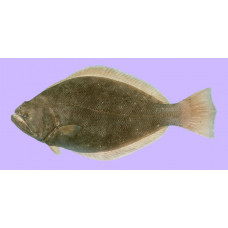Latin name
Psettodes erumei
Other name
Adalah
Identification
The body of the Indian halibut is oval in shape, compressed at the sides, but thicker than other flatfish. The body height is 3.2-3.6 times the total body length. The eyes are located on the right or left side of the body. The eyes are large; the upper eye is located on the top of the head and is set far back from the lower eye, i.e. the interorbital space is wide. The mouth is large, the posterior part extending well beyond the posterior edge of the eye. The lower jaw protrudes slightly forward. The jaws are large, with strong canines, many teeth with pointed tips. There are small teeth on the scutellum and palate. The upper jaw bone is well developed. The edge of the premaxilla is not covered with skin and scales. Lateral line with 61-77 scales, well developed on both sides of the body; makes a slight bend above the pectoral fins; there is no upper bifurcation, a bifurcation of the lateral line passes under the lower eye. There are 32-38 rows of scales around the caudal peduncle. Scales are small, weakly ctenoid on both sides of the body.
Features of fish fins
The beginning of the dorsal fin is well behind the posterior edge of the upper eye. The dorsal fin has 48-56 rays. The anal fin has 34-44 rays. The anterior rays of the dorsal and anal fins are barbed. The urogenital papilla and anal opening are located anterior to the beginning of the anal fin. Caudal fin with 24-25 rays, edge truncated or double truncated, not joined to dorsal and anal fins. Pectoral fins with 13-16 soft rays, of equal length on eye and blind sides. Pelvic fins with 1 barbed and 5 soft rays, symmetrically distributed on each side of the body.
Fish colouring
The ocular side of the Indian halibut is brownish or greyish with 4-5 broad dark stripes running obliquely down the sides of the body. The dorsal, anal and posterior parts of the caudal fins are dark. The blind side is pale brown.
Distribution
Widespread in the Indo-Pacific region. Indian Ocean: from the Red Sea and east coast of Africa to India, Malaysia, Indonesia and Western Australia. Pacific Ocean: from Japan to northern and eastern Australia.
Habitat
Tropical marine demersal fish. They live in coastal waters at depths of 1 to 100 metres (usually 20 to 50 metres) on sandy and muddy bottoms.
Size
The maximum length of the Indian halibut is 64 cm, usually up to 50 cm. Body weight up to 9 kg.
Behavior
Indian halibut burrow into the substrate during the day and hunt at night. They often swim in an upright position, which is not characteristic of flatfish.
Food and feeding habits
Off the coast of Pakistan, juveniles up to 30 cm long feed mainly on cephalopods of the genus Sepia and crabs. Adults switch to a fish diet. The diet includes anchovy and herring.
Reproduction
Off the east coast of India (Tamil Nadu), they first mature at a body length of 371 to 390 mm. They spawn from May to September with a peak from May to August. The caviar is hollowed out in two batches. On the west coast of India (Mumbai), 50% of the females matured at a body length of about 41 cm. Spawning was observed in September-October. The fecundity of females with a length of 43.5 to 52.4 cm ranged from 313.8 thousand to 1219 thousand eggs.
Fishing
Valuable commercial fish. It is caught by bottom trawls and bottom longlines throughout its range.
Relationship with a person
Harmless. It is mainly sold fresh, but is also smoked and frozen. It is processed into fishmeal.
| Classification | |
| Phylum | Chordata |
| Class | Actinopterygii |
| Squad | Carangiformes |
| Family | Psettodidae |
| Genus | Psettodes |
| Species | P. erumei |
| Features | |
| Conservation status | Data deficient |
| Habitat | Bottom |
| Life span, years | No information |
| Maximum body weight, kg | 9 |
| Maximum length, cm | 64 |
| Sailing speed, m/s | No information |
| Threat to people | Edible |
| Way of eating | Predator |
Indian halibut
Tags: indian halibut

